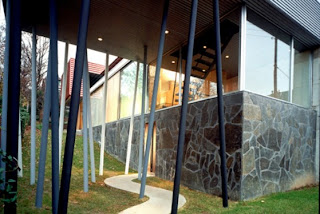Architecture is subjective. There is no set of rules or reasoning that can define architecture. Some may say architecture is the science of design, or an art piece that one can walk through. Others may say architecture is the creation of space or the arrangement of forms. Some might say that only buildings can be counted as architecture while others say memorials and parks are also elements of architecture. A compound might see ornaments as beautiful whereas another sees it as a sin. None of these phrases are correct, nor are they wrong. They are all different point of view or perspective within their opinions, which creates different languages of form to the results in their design. With tens, hundreds, and thousands of languages start to appear in the world of architecture, a call for dominancy in style and form starts to appear in each architect’s compound. Each compound or style is trying to prove to the world that their theories and point of view is correct. However, with the subjectiveness of the architecture, where nothing is right or wrong, a big area is open for arguments. I see this open area as a big battlefield of mind wars. Who can provide the best reasoning and logic behind their creative design? Who can persuade the public into believing that their design is the most rational? The one that wins the debate gets the prize of establishing an era in architecture history.
However, these mind battles do not only happen once, but we see it repetitively throughout the history of architecture. For example, the Renaissance set up a set of rules of proportion and symmetry, and then the Baroque architects come and break down these rules with their invention of the oval and its axi line. Soon later, Modernism comes back with a new set of rules of non-ornamental, non-bourgeois architecture. Then again, the Post-Modernist breaks these sets of rules with the design and with terms like “Less is a bore” and “Grey over Black and White”. The history runs in cycles over and over again like a tug-a-war fight between the “I love making rules” people and the “I love breaking rules” gang. When more people join the “love rules” group, they win, then they get bored and move over to the “hate rules” gang and get bored and move back and forth. What is interesting about this cycle is that even though they are in different time periods with different technology, the rules setters always seem to come back to a similar thinking, BUT with different point of view. Renaissance’s concepts started with the Da Vinci’s diagrammatic drawing of the Vitruvius Man. As the cycle makes the round, Le Corbusier starts another diagrammatic drawing of his Modular Man. Renaissance deals with pure geometry, squares and circles, Modernism comes back with honest forms: same concept different definitions.
These cycles reappear with the same subject, but with different analysis and interpretations. It seems like these architects are asking history questions. “What if” the interpretation of the man can be different from how Da Vinci drew it? - (Le Corbusier) “What if” the same pure forms seen in the Renaissance mean honesty of material and structure? – (Modernism) “What if” we retort the pure shapes like the Baroque architects did? – (Post Modernist) “What if” Robert Venturi’s starting from zero means he is saying starting back at zero? “What if” the Metropolis movie and Playtime movie did not meant what we analyze? “What if” is a question of perspective and point of view. Some things have always existed, but we cannot see to it since our point of view is focused on something else. If we are going to move forward, we must use past events, or history, and existing things to determine our future. To be capable of creating something new, we must question the past and the present. Because architecture is subjective, questioning the past would not give us a right or wrong. It would only give us an opportunity to see things that previous architects have missed out or did not focus on. With different technology and culture growing and changing over time, only if we look back at history, use it well, and ask “What if … ?”, we may be exploring a whole new set of concepts that have not been seen, even if it is based on the same subject. “What if?”




















